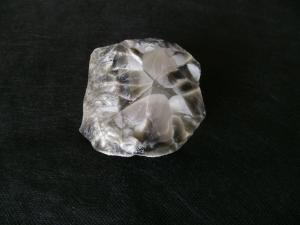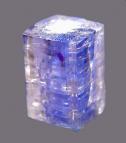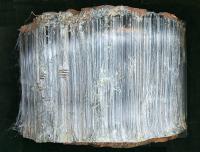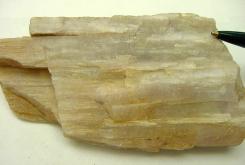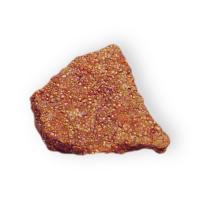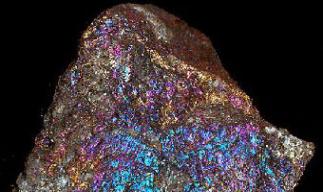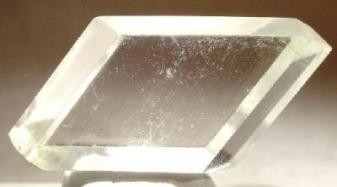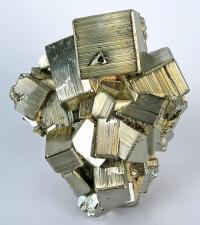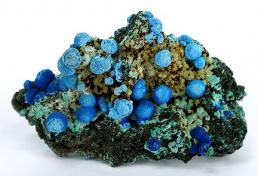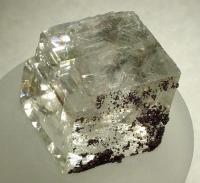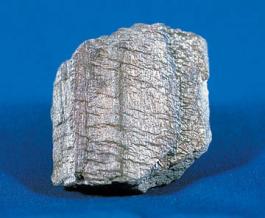Mineral Classification 2
Another important mineral identification technique is to determine a mineral's hardness. There are many minerals that are white in color and may leave a white streak, but if you find out the mineral's hardness you can eliminate some of the potential minerals when trying to ID the mineral.
Geologists use a scale called Moh's Scale of Mineral Hardness. This scale is not about understanding an "absolute" hardness, but rather compares the hardness of one mineral to another. For example, the mineral talc and the mineral gypsum are very similar in nature. They both tend to be white in color and tend to leave a whiteish streak, but talc is much softer than gypsum. In fact, talc is the softest mineral on Earth and therefore is at the bottom of the Moh's Scale of Mineral Hardness. Gypsum can scratch talc but talc is too soft to scratch gypsum.
The hardest mineral on the Earth is the diamond and therefore is at the top of the hardness scale and has a relative hardness of 10.
Do not confuse hardness with the ability to break. If you hit a diamond with a hammer you probably can get it to shatter into multiple pieces, but if you hit copper with a hammer it might not be as brittle as metallic minerals tend to leave a dent and not shatter when being struck with an object. The hardness scale is used to determine a mineral's ability to scratch another object.
Below is a table of the entire Moh's Scale of Mineral Hardness.
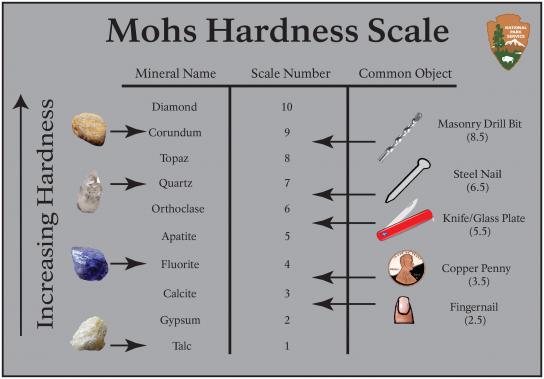
When trying to identify a mineral, a geologist probably isn't going around carrying diamonds nor does he want to scratch mineral samples, and the amateur mineralogist might not even have samples of all of these minerals. This is why there is a common items list that can help you identify minerals.
|
2.5 |
Fingernail |
| 4-5 | Iron Nail |
| 5.5 | Knife blade |
| 6-7 | Glass |
For our labs, we will be using some of these items to help us identify our minerals. So if your mineral can scratch glass you know it must be harder than 6. If a mineral cannot scratch your fingernail then you know it must be softer than 2.5. If a mineral can scratch your fingernail but not an iron nail, then the mineral must be greater than 2.5 but less than 4. This is the thought process behind using Moh's Scale of Mineral Hardness.
The last step to identifying minerals is to understand that some minerals have very unique properties to them. Because of some of these unique properties, you can easily identify some minerals. For example, the mineral sulfur smells and burns like sulfur; the same sulfur you find in a match head. Halite tastes salty because it is salt. Below are some samples of minerals with unique properties.
There are many other unique properties. Here is a list of words you might come across when trying to identify minerals.
|
Fracture: Uneven breaks. Breaks like glass. Shattered looking. |
Translucent: You can see into the mineral but not necessarily all the way through. |
|
Fibrous: fiber looking |
Pisolitic: Spheres of calcium carbonate or other minerals. |
|
Opaque: Cannot see through or into the mineral. |
Conchoidal fracture: breaks like glass. Not shattered-looking. How obsidian (arrowheads) break. |
|
Oolitic: has spheres, round-looking objects. |
Iridescent colors: colors seem to change at different angles. |
|
Vitreous: like glass in appearance |
Transparent: Can see all the way through. |
|
Striations: linear marks |
Adamantine: Brilliant or sparkly like a diamond |
|
Variegated: Exhibiting different colors |
Rhombic: Equilateral parallelogram |
|
Foliated: One sheet laying on top of another. |
Isometric: equal dimensions |
You can also use Specific Gravity, a fancy way of saying the density of objects on Earth. You have already done a lab where we determined specific gravity/density by dividing a rock's mass by its volume found in water. Metallic minerals tend to be denser than non-metallic minerals.
Moh's Scale of Mineral Hardness Activity
- Individually, using the Moh's Scale, a piece of glass, and your fingernail, determine the hardness of each mineral by yourself and write down your answer in the shaded cell for each mineral. Answers will include: Soft for minerals <2.5, Medium for minerals between 2.5 and 6, and Hard if >6. In other words, Soft if your fingernail can scratch it, Medium if you can't scratch it with your fingernail but it won't scratch glass, and Hard if it scratches glass.
- Then compare your results with that of your group. In the non-shaded hardness cell, write down the group's majority determination of the mineral's hardness.
- As a group, determines special properties that your mineral might contain and write those down in the "Other Properties" column.
Now that you understand what many of the mineral characteristics are, it is time to use all of your gathered information and identify the minerals in your kit. Scientists use a dichotomous key to identify minerals. Dichotomous means to divide into. Scientists use dichotomous keys in many areas of science to help identify objects like rocks, minerals, plants, and animals. We will use dichotomous keys to help identify minerals and rocks in this and upcoming lessons.
Dichotomous keys use questions to help focus a direction in determining what type of mineral you have. In this case, we are going to ask the questions in the following manner.
- What type of luster does the mineral have? Is it metallic or nonmetallic? Just by knowing this question you can eliminate many minerals.
- How hard is the mineral? You can eliminate many other choices just by knowing that you have a soft, medium, or hard mineral by using the scratch test.
- Does your mineral have Excellent, poor, or no cleavage at all? This question too will eliminate many possibilities.
- Now that you have eliminated a whole bunch of potential minerals you then ask what color of streak it has, what is the main color of the mineral, what are some of the unique properties it has, and finally, you can determine what the specific gravity/density it has.
Before you identify your own minerals, use a dichotomous key to help you identify the minerals in the following assignment.
If you are not a SUSD5 student you can buy this mineral dichotomous key activity at Teachers Pay Teacher for 0.85 cents.
Now that you have discovered many characteristics of your kit's minerals, use a dichotomous key to identify them.










